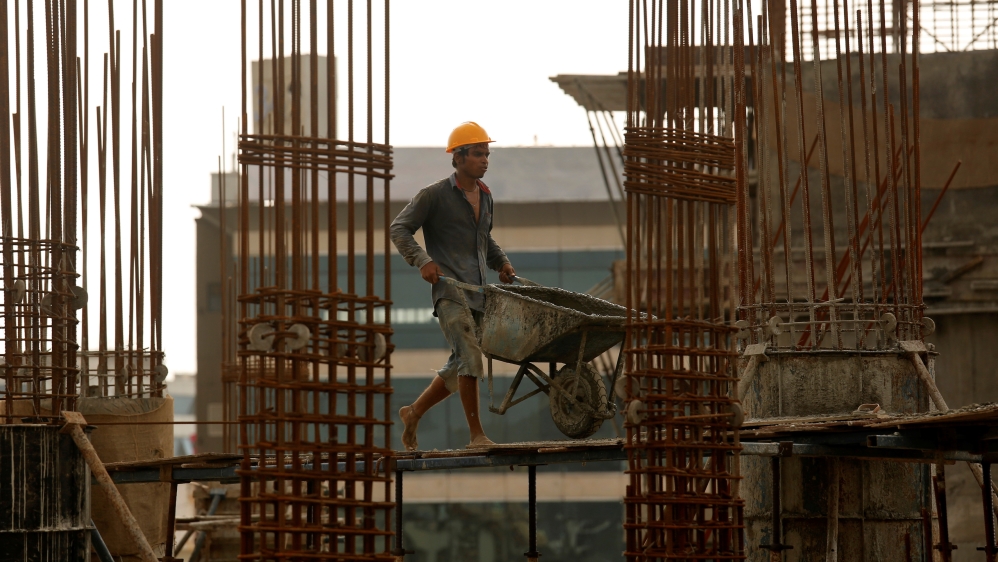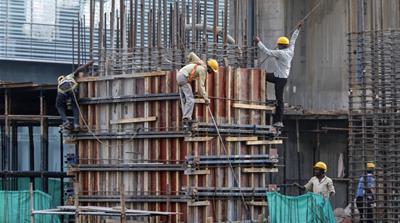India at work: Labour reforms aim to boost wages and productivity
Critics of the new reforms say streamlining India’s complex labour laws may help companies more than workers.

Mumbai, India – Each day is a new test of Deepak Kumar’s resolve as he waits with dozens of others outside the Khar railway station in India ‘s financial capital, Mumbai, hoping to be hired by local contractors for a day’s work on a construction site.
“It’s always the same risky work and the hours never change, but the pay varies a lot,” Kumar tells Al Jazeera. Beholden to the whims of the “bosses” of the construction firms, his income sometimes dips below the customary $7-per-day rate for inner-city Mumbai, pushing his finances to the brink, he says.
Keep reading
list of 4 itemsTrapped, abandoned: Filipino workers lured to Poland by shadowy agents
EU countries endorse diluted draft rules on gig economy workers’ rights
On 40th anniversary of UK miners’ strike, can Labour win back the north?
“Right now it’s too hard to plan for the future. I don’t know what I’ll earn tomorrow and I have to send half my earnings back to my family in Bihar [state],” Kumar says, referring to the state in India’s northeastern corner, one of the poorest in the country.
“I also worry about working without any protective gear when we’re not hired by the large companies,” he adds.
As a labourer in the informal sector, flipping between physically demanding jobs that offer no social security benefits such as pensions, 23-year-old Kumar is among the 500 million workers that India’s Ministry of Labour and Employment says will benefit from legal reforms.
But critics argue that proposals to streamline India’s labour laws, which involve the adoption of internet-based solutions, will be difficult to implement while the country suffers from ageing telecommunications and power infrastructure. And they say the changes could end up benefiting companies more than workers.
India has begun the process of consolidating its 44 labour laws into a more manageable set of four new codes. They will govern wages, industrial relations, social security provision and working conditions.
The codes aim to raise incomes and social security levels for the 90 percent of India’s workers who are employed in the informal sector, while at the same time helping businesses become more competitive and boosting an economy that is showing signs of a slowdown.
Many economists say a modernisation of India’s labour laws is long overdue.
“Forming a cohesive industrial policy is more crucial for India now than ever before,” Jayan Jose Thomas, associate professor of economics at the Indian Institute of Technology Delhi, told Al Jazeera.
“Increasing wages and lifting incomes can also help fuel demand for goods, boosting industrial growth in the domestic market,” he added.
India’s tough labour laws have been blamed for keeping manufacturing businesses small and hindering job creation. For instance, if an organisation grows beyond a hundred employees, it needs to seek the government’s permission to let go of staff or dismantle units. Meanwhile, registering a business invites a mountain of paperwork, meaning many firms remain in the informal sector.
The government is optimistic that its reforms will prove successful. The most recent Economic Survey, a summary of economic performance prepared by the Ministry of Finance, noted that factories in the western state of Rajasthan employing more than 100 workers grew at 9.3 percent per annum two years after deregulating certain state labour laws.
That compared to 3.7 percent per annum growth in the two years prior to the reforms – a sign, the government says, that reforms that make it easier for companies to sack people could ironically create more jobs by allowing those firms to be nimble.
Unemployment in India reached a 45-year high in 2018. The latest figures from the Centre for Monitoring Indian Economy show it at a three-year high of 8.1 percent in October. It has become a growing source of pain for the Bharatiya Janata Party-led government, which came to power in 2014 – in part on the promise that it would create more jobs.
Raising incomes, formalising the workforce
As important as creating new jobs is, ensuring that those who are currently employed are paid adequately is another goal of the government’s labour reforms.
The new laws mandate a national minimum wage of 176 rupees ($2.50) per hour.
India has had a minimum wage law in place since 1948, but it has varied widely.
The law’s complex structure, coupled with poor oversight, means there was little incentive to implement it. According to the government’s Periodic Labour Force Survey 2017-18, 45 percent of employees in the formal sector are paid less than the minimum wage.
The new Code on Wages Bill 2019, passed by parliament on July 30th, seeks to correct this by streamlining the myriad different minimum wages in place for various sectors and subsequently reducing the costs for employers to comply with wage rules.

One example of the complexity of the rules concerns mineworkers involved in crushing stones. Those working with soft soil are eligible to a minimum wage of 376 rupees ($5.31) a day, while for those working with hard rock, the statutory rate is 750 rupees ($10.60), according to government data.
But it is not clear how the new minimum wage will be enforced. With few jobs to go around, workers could be powerless to force employers to comply.
“Look around you, there are so many men here needing work that making demands of the bosses is impossible – they’ll just tell you to move off,” said Rohit Singh, a 23-year-old migrant worker from Rajasthan.
Sharmila Kantha, a principal consultant at the Confederation of Indian Industry, suggests that the government’s plans to furnish each worker with a unique identification number and card could help to make sure companies comply with the new rules. But even this system is likely to have its limitations, Kantha says.
“A smart card system could help keep track of wage payments, if state governments ensure its roll-out,” she said. “However, with many informal workers engaged in multiple jobs and with multiple employers and self-employment in any given week, it will be difficult.”
Removing hurdles, widening safety nets
Of the many proposed reforms, businesses will perhaps be cheering the end of the so-called “Inspector Raj” phenomena the most. Many have long complained of government inspectors harassing businesses and soliciting bribes in exchange for the right licences and documentation.
“The current inspection system is akin to a racket,” a textile manufacturer who did not wish to be named told Al Jazeera. “Each month the inspector arrives on the same day and I know how much I will need to pay him to ensure he leaves me and my factory alone”.
Under the aegis of a new algorithm, visits will now be scheduled and assigned to inspectors at random. A new online portal will also allow businesses to self-report and upload documents themselves, in an attempt to reduce their compliance burden.

Yet while the proposed labour codes include further provisions to help business – such as streamlining the number of licences and permits required to operate legally and increasing the minimum number of employees needed to form a union – some are unsure such measures will deliver the productivity boost for which the government is hoping.
“If you reflect on what has constrained economic activity in the country, there are other bottlenecks that are more severe than trade unions and inspector harassment,” K R Shyam Sundar, a professor at the Xavier School of Management in Jamshedpur, told Al Jazeera. “Labour regulations are never the top concern of business owners,” he added.
The textile manufacturer agrees, explaining that inadequate financing, power supplies and infrastructure are hindering manufacturing processes more than inflexible labour laws.
“Sure, you can create online systems for businesses to upload reports themselves,” he said. “But for that to work, you also need to ensure reliable internet service and power supply outside of the big cities too, where factories are located.”
Some are also warning that the reforms appear too business-friendly – and could hurt workers’ interests.
Left-leaning trade unions held a joint protest in recent weeks opposing new legislation that governs wages and working conditions.
The codes “curtail the rights of workers” and are an oversimplification, they said in a statement. The unions are also disappointed that they had not been consulted during the bill-drafting process and that many of the suggestions put forward by an expert committee – such as a daily national minimum wage floor that is significantly higher than the $2.50 that has been implemented – have not been taken up.
This is the first of a two-part series looking at how recent changes to India’s labour laws are likely to affect ordinary people and the broader economy.